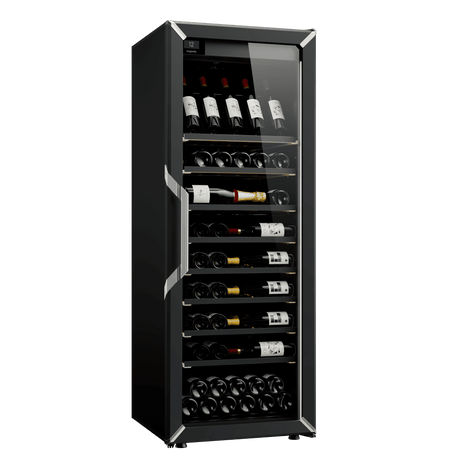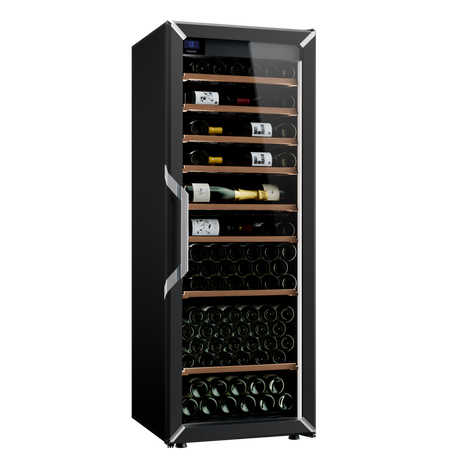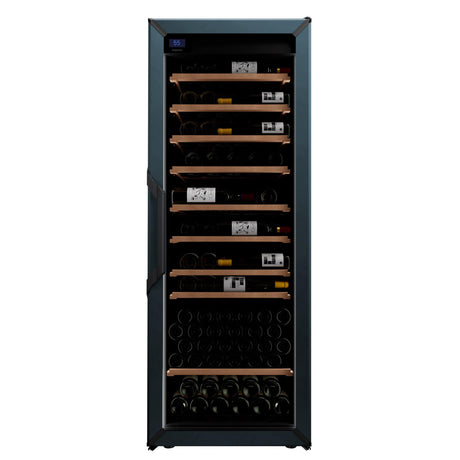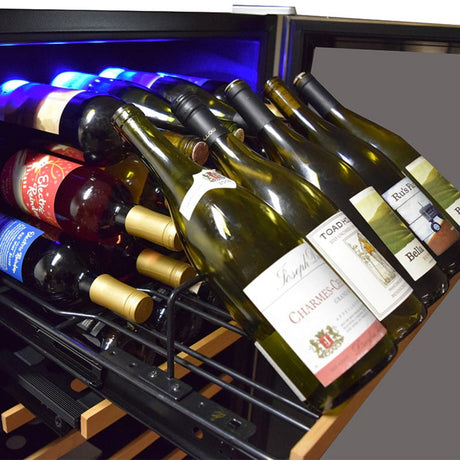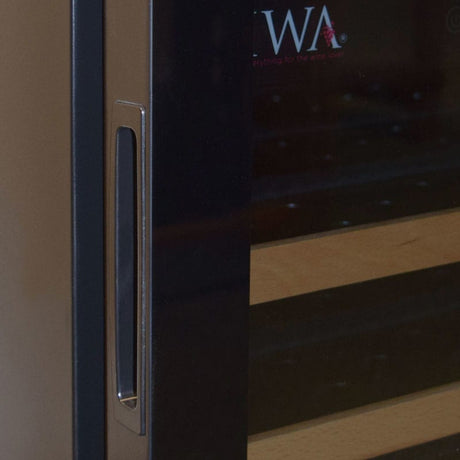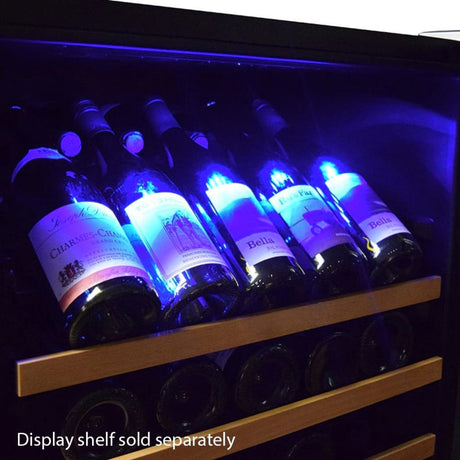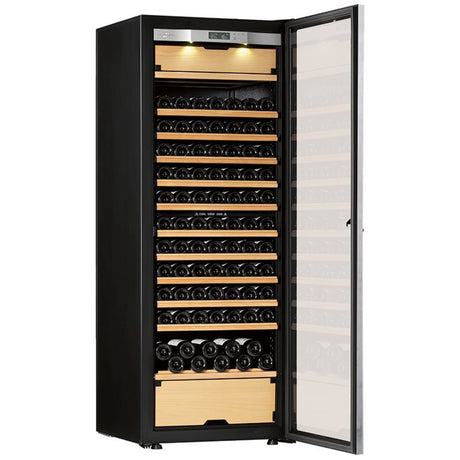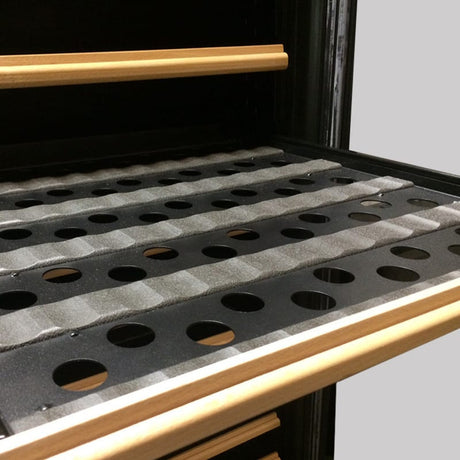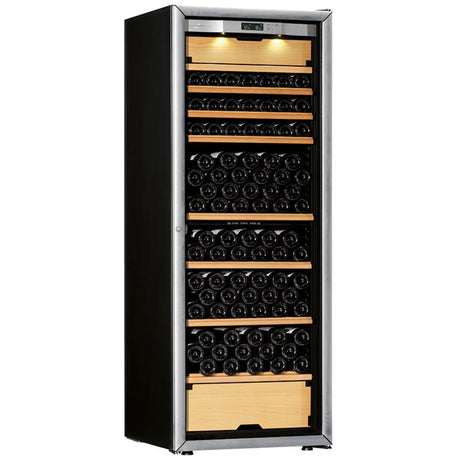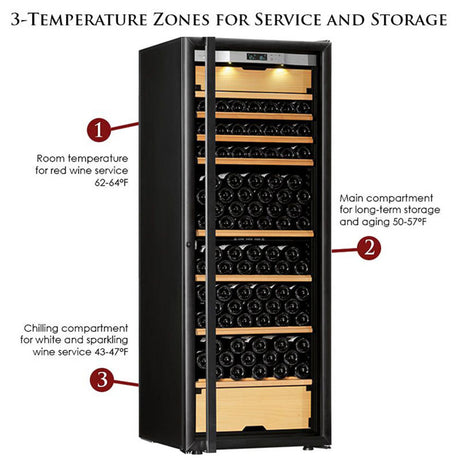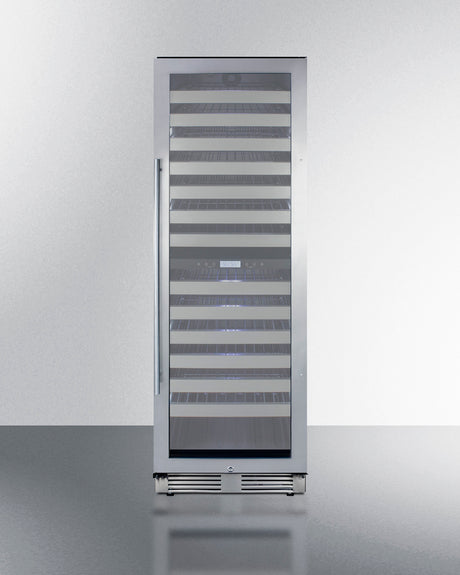Goguette by Eurocave Group
Shop 17 WCHQ 101 - 200 Bottle Wine Coolers (Medium) Products
-
$4,995.00In stock (120 units)
-
-
-
-
-
-
-
-
-
-
-
-
-
-
Sold out
-
Sold out
-
Benefits
Generous Capacity
Designed to hold up to 200 standard 750ml wine bottles: these wine refrigerators are an investment for seasoned wine collectors or anyone who loves to entertain and showcase their love of fine wines. Ideal as 150 bottle wine fridges.
Wine Preservation
Quality wine fridges utilize state-of-the-art wine cooling technology to keep your wines in perfect condition. They regulate temperature and manage humidity levels to preserve the integrity of delicate wines and ensure they are always at ambient drinking temperature.
Highly Versatile
Invest in a quality wine refrigerator with adjustable shelving; you can store almost any bottle of wine, from Piccolos to Magnums.
Aesthetically Pleasing
200-bottle wine fridges are sleek, sophisticated, and styled to complement modern interiors.
Energy-Efficient
Most modern wine fridges are energy-efficient and economical. Check the Energy Guide Label to find out how much it will cost to run for a year.
Essential For The Entertainer
If you love to entertain, a 200-bottle wine fridge will ensure you always have perfectly chilled wine for an impromptu party, family get-together, or special occasion.
UV Protection
Top-of-the-range wine fridges have UV-protected glass doors to protect your wine collection from harmful UV light.
Silent Operation
Thanks to advances in cooling technology, wine fridges are quieter than ever before: even 200-bottle designs.
Red Wines Age Beautifully In Wine Fridges
Set your wine fridge to 62 - 68°F, and your red wines will thrive just as well as your whites and rose wines.
Protects Your Investment
Poor storage can ruin a fine wine collection. Protect your investment with a 200-bottle wine fridge; your special reserves could last years.
How To Choose
Temperature Zone Control
Different wines require different storage temperatures to maintain their aromas and flavor profile, so your wine cooler must offer multiple zone controls to keep your reds, whites, roses, and sparkling wines at the perfect serving temperature.
A dual-zone fridge may be sufficient if you only collect one or two varieties, but when investing in a wine cooler of this size, it makes sense to invest in one with multiple temperature zones.
Humidity Control
While many wines have screw caps rather than corks, most fine wines come with traditional cork closures that require extra care.
Humidity control is essential when storing reserve wines in a wine fridge; without it, your corks could shrink and spoil your entire collection. Aim for 60-70 percent humidity to prevent dryness and keep mold and mildew at bay.
UV-Protected Doors
Most high-end wine refrigerators have UV-protected glass doors to protect prized collections against harmful UV rays that can quickly degrade fine wines.
Look for this feature when shopping for your wine fridge.
Anti-Vibration Technology
Is your wine fridge equipped with anti-vibration technology? Older wines, particularly reds, and champagnes, can be severely affected by constant vibrations, which disturb the sediment in the bottle and cause premature aging.
Invest in a wine fridge with this feature if you intend to age your collection.
Adjustable Shelves
Wine bottles come in various shapes and sizes, so make sure your wine fridge has adjustable shelves.
While wooden shelves will give your wine cooler a more traditional and authentic feel, metal shelves work just as well, but they should be height adjustable for optimal flexibility.
Integrated Locking Mechanism
Some wine fridges come with lockable doors. If you have a valuable collection or minors at home, consider this option for peace of mind.
Energy Efficiency
An energy-efficient wine fridge will save money on energy bills and lower your carbon footprint. Check the energy guide label and choose the most energy-efficient model for eco-conscious homes.
Noise Reduction Technology
Our wine fridges are available with compressor or thermoelectric cooling technology. Compressor models are typically noisier than thermoelectric models, so bear this in mind when shopping for a wine refrigerator for your business or home.
Aesthetics
Most wine fridges are aesthetically pleasing, but some are more so than others. While functionality will always be a priority, a designer-inspired wine fridge with glass doors, LED lighting, and wooden shelving will make an eye-catching addition to any corner of the home.
Price & Warranty
How much would you expect to pay for a 200-bottle wine fridge? The most basic models start at around $1,800, but you should expect to pay $5,000 or more for a high-end wine refrigerator with multiple temperature zones and noise-reduction technology.
Once you have determined your budget, look for a model that meets your needs and includes an extended warranty.
Types
Single Temperature Zone Wine Fridge
Single-zone wine fridges are the most economical option for those on a budget. As the name suggests, these wine refrigerators have a single temperature control, so they are best suited to storing reds or whites, but not both.
You can set the temperature to complement your collection, which is typically 48 - 55°F for white wines and 60 - 65°F for red wines, and it will keep them at the perfect storing and serving temperature.
Dual Temperature Zone Wine Fridge
Wine connoisseurs who enjoy red and white wines and the odd glass of champagne should choose a dual-temperature zone wine fridge.
You can set two temperature zones within the unit and keep your Sauvignon Blancs and Chardonnay wines at a perfectly chilled 48°F and your Malbecs and Pinot Noir collection at an ambient 62°F.
These wine coolers cost slightly more than the single-zone alternatives, but they are worth the investment if you enjoy all wine varieties.
Built-In Wine Fridge
One of the many benefits of built-in wine fridges is that they slot seamlessly into existing cabinetry or under counters for an integrated look.
Unlike freestanding wine fridges, built-in models have a front venting system to prevent overheating, and they typically come with black glass or mirrored doors with various LED lighting options.
Freestanding Wine Fridge
The beauty of freestanding wine fridges is that you can position them anywhere there is a power outlet and relocate them with ease.
They are versatile, portable, and easy to install, but as they have rear venting systems, they need clearance on all sides to prevent overheating.
Thermoelectric Wine Fridge
Thermoelectric wine fridges are energy-efficient, vibration-free, and equipped with noise-reduction technology for silent operation. They are ideal for domestic installations and perfect for storing sensitive vintages that don’t like noise or vibration.
One thing to note with thermoelectric wine fridges is they don’t perform as well in warm conditions. If you live in a state known for its high temperatures, a compressor wine fridge might be a better investment for your home.
Compressor Wine Fridge
Equipped with compressor technology to keep your wines perfectly chilled, compressor wine fridges work much the same as kitchen refrigerators.
They are slightly noisier than the thermoelectric alternatives, and some models vibrate more than many wines would like, but when it comes to cooling wine in warm temperatures, they are unbeatable on many levels.
Alternatives
If you love to indulge in a glass (or two!), a 200-bottle wine fridge could be the perfect investment for your home. It will preserve the delicate flavors of your white and rose wines and age your red wines to perfection.
Large wine refrigerators often include advanced features such as temperature, humidity, and noise control, and many have lockable doors to prevent unauthorized access, but you need to drink a considerable amount of wine to make it truly worth your investment.
Here are some alternatives you may want to consider:
Alternative Wine Storage for Private Collectors
200-bottle wine fridges can hold a substantial amount of wine, but if your collection extends to several hundred bottles, you may need something bigger, such as a custom-built wine cellar.
Of course, you’ll need space for a wine cellar, and it will require some investment, but once installed, it will provide the perfect conditions for your growing wine collection and a great place to get together with friends.
Alternative Wine Storage for Wine Investors
If you buy and trade fine wines for a living, you must store them at the perfect temperature.
Those with space at home typically use a 200-bottle wine fridge to store their collections, but if you don’t have the space for a wine cooler, you could use a professional wine storage service instead.
Many companies offer professional wine storage throughout the US, with additional add-ons such as inventory management, transport, shipping, and insurance.
Alternative Wine Storage for Bars & Restaurants
While restauranteurs typically invest in a 200-bottle wine fridge to store their in-house collections, wine bar owners may prefer a commercial wine dispenser if they sell their wines by the glass.
Equipped with cooling technology and volume-adjustable dispensers, these wine storage systems eliminate waste and maximize turnover by ensuring every glass has the perfect serving.
Alternative Wine Storage for Hospitality & Event Catering Providers
Hosting events requires careful planning; and, in most circumstances, a substantial amount of wine. Freestanding wine fridges are popular with many catering providers due to their portability, but they are best suited to indoor events.
An alternative for outdoor catering and events could be a refrigerated trailer or traditional ice buckets placed on each table.
How to Install & Maintain
Where to Place Your Wine Fridge
Both built-in and freestanding wine fridges need ample space for ventilation, and you need additional clearance for the doors.
Bear this in mind when allocating space for your new wine cooler, and make sure you can comfortably access all areas, even the back of the fridge, to get the most out of your investment.
Top Tip: Measure the space available for your wine fridge before you shop. If you intend to install a built-in wine fridge, make sure the cabinet can comfortably accommodate the fridge's height, width, and depth without overlapping.
Remember that ventilation is key if you decide on a freestanding wine refrigerator.
Power Outlets & Backup
Your wine fridge will likely need a 120V power outlet. For safety reasons, avoid using extension cables and plug your wine refrigerator directly into the wall socket. If you live in an area prone to power outages, consider investing in a backup or generator to protect your wine collection.
Top Tip: Could a wine fridge overload your circuit? Check with your local electrician if in doubt.
Temperature Zones & Humidity Control
If your wine collection includes a mix of reds, whites, rose, and sparkling wines, choose a wine fridge with multiple temperature zones. If you collect expensive red wines, you’ll need humidity control too.
Top Tip: You can save space in your wine fridge by storing similar wines together. Set one temperature zone for your sparkling wines and champagnes, another for white and rose wines, and a third for your reds.
Always close the doors; leaving them open for a few minutes can disrupt the temperature of your wine fridge, and check humidity levels frequently to ensure they never go below 60 or above 70 percent.
Professional Installation
Installing a wine fridge is more complex than it seems. Wine coolers of this size are difficult to maneuver, not to mention heavy. If you find installing it yourself too daunting, get professional help from an installation company.
Top Tip: Ask your wine fridge retailer to recommend a company to help you transport and install your new refrigerator. It may cost a few hundred dollars, but it is a small price for your safety and peace of mind.
Wine Fridge Maintenance
To keep your new wine fridge in perfect working order, clean it regularly, just like your kitchen refrigerator. Take extra care to remove dust and debris from the venting system, cooling system, door seals, and shelves.
Top Tip: Empty your wine fridge once per year for a thorough clean. During this time, you can also count your inventory and bring any bottles approaching their expiry date to the front of the fridge for consumption.
FAQs
Do large-capacity wine fridges consume more power than standard fridges?
The answer to this question depends on the model you choose. Most modern wine fridges are energy-efficient and don’t use any more power than a large fridge-freezer. Check the Energy Guide Label for further details.
What type of wine can your store in a wine fridge?
You can store white, rose, red, and sparkling wines in a wine fridge, but if you intend to keep a mixed collection, you’ll need a fridge with multiple temperature zones. Cheaper options have only one temperature zone, so bear this in mind when shopping for this type of appliance.
Do wine fridges have temperature control?
Yes, just like your kitchen fridge, wine fridges have adjustable temperature controls, but as we mentioned above, some only have one zone, while others have two or more.
Are wine fridges noisy?
Most modern wine fridges are equipped with noise reduction technology, although those with compressor coolers create the same amount of noise as large domestic fridges and freezers.
Is it possible to build wine fridges into cabinetry?
Yes, look for a built-in or under-counter wine fridge. These models have front ventilation systems, so you can easily install them into (or under) cabinets.
What is the best way to clean a wine fridge?
The best way to clean a wine refrigerator is with mild detergent, warm water, and a soft cloth. Avoid using scented detergents, harsh chemicals, and abrasive cleaners. Use a soft brush to remove dust and dirt from the ventilation system and check any filters for blockages.
What is the best way to install a wine fridge?
Wine fridges are big, bulky, and heavy. We recommend using a professional installation company to deliver and install your new fridge. It will save you time and effort and could even save you money in the long run.
Can I store beers and soft drinks in a wine fridge?
Yes, you can keep all kinds of beverages in your wine fridge, but if you only have one temperature zone, your beers and sodas might be warmer than you would like.
Are wine fridges expensive to repair?
If something goes wrong with your wine fridge once your warranty has expired, you’ll likely have to pay for spares and repairs. Expect to pay the same as you would to repair your fridge-freezer.




